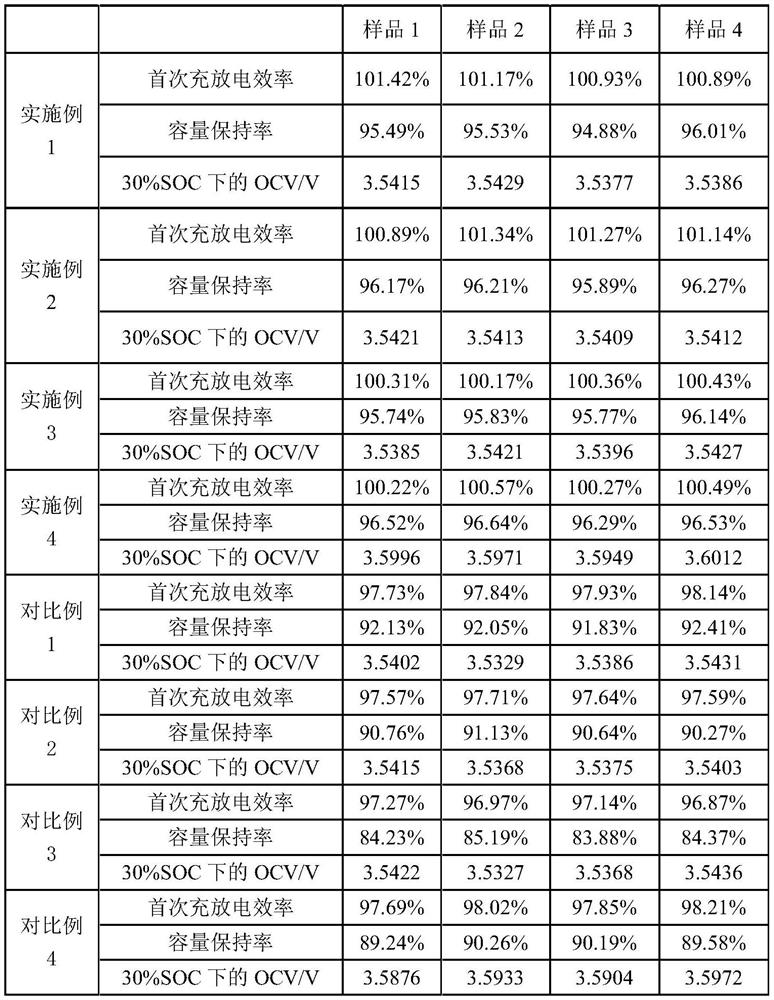A method for double heat treatment and rapid formation of batteries coated with artificial sei film negative pole pieces
A membrane negative electrode and cell technology, which is applied in the field of dual heat treatment and rapid formation of cells, can solve the problems of lithium deposition or black spots, low cell capacity consistency, and extended working hours, so as to avoid poor voltage consistency and improve Cycling stability, the effect of ensuring voltage consistency
- Summary
- Abstract
- Description
- Claims
- Application Information
AI Technical Summary
Problems solved by technology
Method used
Image
Examples
Embodiment 1
[0043] 1) Coating a silicon carbon negative electrode material ([SiO 2 @Graphite) aqueous solution, the content of silicon oxide in the silicon carbon negative electrode material is 2wt%, and then dried at 90°C for 2 hours, forming a silicon carbon negative electrode layer with a thickness of 117 μm on the surface of the current collector;
[0044] 2) Use molecular layer deposition equipment (Note: Boinst MLD, Beijing Boying Technology Co., Ltd., Boinst-PMLD100) to combine trimethylaluminum (TMA) and ethylene glycol (EG) according to: TMA—pulse (0.01s)—blowing The sequence of sweeping (40s)—EG—pulse (0.01s)—purge (70s) is alternately deposited on the surface of the silicon carbon coating. The thickness of the formed polymer aluminum film layer is 0.8 μm, and the mass ratio of trimethylaluminum to ethylene glycol is 1:3;
[0045] 3) After lamination, the temperature of the upper and lower splints of the hot-press tooling is set to 80°C, the pressure of the upper and lower spli...
Embodiment 2
[0055] 1) Coat the surface of the copper current collector with an aqueous solution of silicon-carbon anode material ([SiO2@Graphite) with a concentration of 45wt%. The content of silicon oxide in the silicon-carbon anode material is 2wt%. A silicon carbon negative electrode layer with a thickness of 117 μm is formed on the surface;
[0056] 2) Use molecular layer deposition equipment (Note: Boinst MLD, Beijing Boying Technology Co., Ltd., Boinst-PMLD100) to combine trimethylaluminum (TMA) and ethylene glycol (EG) according to: TMA—pulse (0.01s)—blowing The sequence of sweeping (40s)—EG—pulse (0.01s)—purge (70s) is alternately deposited on the surface of the silicon carbon coating. The thickness of the formed polymer aluminum film layer is 0.8 μm, and the mass ratio of trimethylaluminum to ethylene glycol is 1:3;
[0057] 3) After lamination, the temperature of the upper and lower splints of the hot-press tooling is set to 100°C, the pressure of the upper and lower splints is...
Embodiment 3
[0067] 1) Coating a silicon carbon negative electrode material ([SiO 2 @Graphite) aqueous solution, the content of silicon oxide in the silicon carbon negative electrode material is 2wt%, and then dried at 90°C for 2 hours, forming a silicon carbon negative electrode layer with a thickness of 117 μm on the surface of the current collector;
[0068] 2) Use molecular layer deposition equipment (Note: Boinst MLD, Beijing Boying Technology Co., Ltd., Boinst-PMLD100) to combine trimethylaluminum (TMA) and ethylene glycol (EG) according to: TMA—pulse (0.01s)—blowing The sequence of sweeping (40s)—EG—pulse (0.01s)—purge (70s) is alternately deposited on the surface of the silicon carbon coating. The thickness of the formed polymer aluminum film layer is 0.8 μm, and the mass ratio of trimethylaluminum to ethylene glycol is 1:3;
[0069] 3) The temperature of the upper and lower splints of the hot-press tooling after lamination is set to 120°C, the pressure of the upper and lower spli...
PUM
| Property | Measurement | Unit |
|---|---|---|
| thickness | aaaaa | aaaaa |
| thickness | aaaaa | aaaaa |
| thickness | aaaaa | aaaaa |
Abstract
Description
Claims
Application Information
 Login to View More
Login to View More - R&D
- Intellectual Property
- Life Sciences
- Materials
- Tech Scout
- Unparalleled Data Quality
- Higher Quality Content
- 60% Fewer Hallucinations
Browse by: Latest US Patents, China's latest patents, Technical Efficacy Thesaurus, Application Domain, Technology Topic, Popular Technical Reports.
© 2025 PatSnap. All rights reserved.Legal|Privacy policy|Modern Slavery Act Transparency Statement|Sitemap|About US| Contact US: help@patsnap.com

